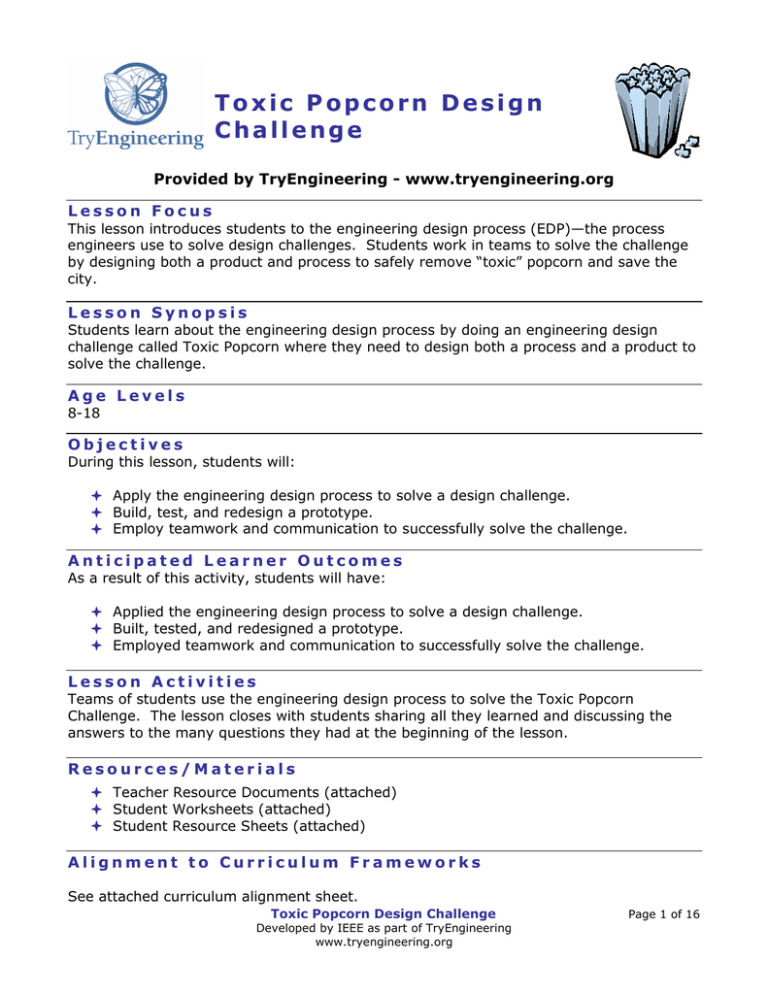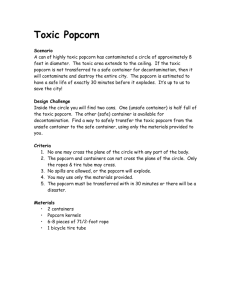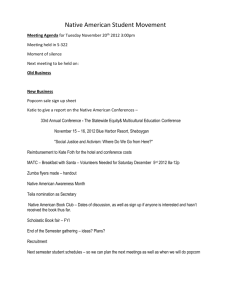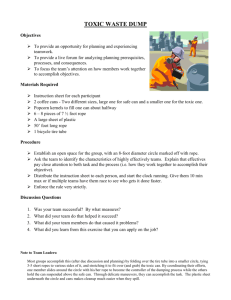Toxic Popcorn Design Challenge
advertisement

Toxic Popcorn Design Challenge Provided by TryEngineering - www.tryengineering.org Lesson Focus This lesson introduces students to the engineering design process (EDP)—the process engineers use to solve design challenges. Students work in teams to solve the challenge by designing both a product and process to safely remove “toxic” popcorn and save the city. Lesson Synopsis Students learn about the engineering design process by doing an engineering design challenge called Toxic Popcorn where they need to design both a process and a product to solve the challenge. Age Levels 8-18 Objectives During this lesson, students will: Apply the engineering design process to solve a design challenge. Build, test, and redesign a prototype. Employ teamwork and communication to successfully solve the challenge. Anticipated Learner Outcomes As a result of this activity, students will have: Applied the engineering design process to solve a design challenge. Built, tested, and redesigned a prototype. Employed teamwork and communication to successfully solve the challenge. Lesson Activities Teams of students use the engineering design process to solve the Toxic Popcorn Challenge. The lesson closes with students sharing all they learned and discussing the answers to the many questions they had at the beginning of the lesson. Resources/Materials Teacher Resource Documents (attached) Student Worksheets (attached) Student Resource Sheets (attached) Alignment to Curriculum Frameworks See attached curriculum alignment sheet. Toxic Popcorn Design Challenge Developed by IEEE as part of TryEngineering www.tryengineering.org Page 1 of 16 Internet Connections Greatest Engineering Achievements of the 20th Century: (www.greatachievements.org) TryEngineering (www.tryengineering.org) IEEE Global History Network (www.ieeeghn.org) ITEA Standards for Technological Literacy: Content for the Study of Technology (www.iteaconnect.org/TAA) National Science Education Standards (www.nsta.org/publications/nses.aspx) Recommended Reading Engineering the City: How Infrastructure Works (978-1556524196) Waste Management (978-1553193074) Optional Writing Activity Teams design their product and process only on paper and then pass their "report" (sketches and written description of design and process) to another team to build and test. This activity will reveal if the report was clearly written. Toxic Popcorn Design Challenge Developed by IEEE as part of TryEngineering www.tryengineering.org Page 2 of 16 Toxic Popcorn Design Challenge For Teachers: Teacher Resources Lesson Goal The goal of this lesson is that teams of students use the engineering design process to solve the Toxic Popcorn Challenge. Students must develop a product and process to transfer toxic popcorn to a safe location and save the city. Lesson Objectives During this lesson, students will: Apply the engineering design process to solve a design challenge. Build, test, and redesign a prototype. Employ teamwork and communication to successfully solve the challenge. Materials One full set of material for each team 2 containers (plastics containers with lips are great)- should be slightly different size than the containers used for the actual toxic zone. 100-200 pennies in a zip lock bag (represents the toxic popcorn) 6-8 pieces of 71/2-foot rope (clothesline rope works great!) 1 bicycle tire tube 18” diameter 1 hula-hoop 3’-4’ diameter (other options: rope taped down or a circle cut from a paper table cloth) 1 piece of large flip chart paper 1 marker EDP worksheet (per student) One full set of material for ACTUAL TOXIC ZONE 2 containers (plastics containers with lips are great) Popcorn kernels (fill about 1/2 of the container) 1 hula-hoop 3’-4’ diameter (other options: rope taped down or a circle cut from a paper table cloth) Grade Level Modifications For ages 9 and younger use marshmallows instead of popcorn. The lighter the material to be transferred the easier the challenge. For ages 14 and older instead of a hula hoop use a circular table cloth 8’ in diameter (or taped down rope). The larger the diameter the more difficult the challenge. Also for older students containers without a lip will be more of challenge—coffee cans work well. Time Needed: One-two 45 minute sessions The lesson can be done in as little as 1 class period for older students. However, you don’t want students to feel rushed. So, to ensure student success (especially for younger students), split it into two periods giving students more time to brainstorm and test ideas and hold the final challenge the next class period. Toxic Popcorn Design Challenge Developed by IEEE as part of TryEngineering www.tryengineering.org Page 3 of 16 Toxic Popcorn Design Challenge For Teachers (continued): Procedure 1. Break class into teams of 4 (or up to 6). 2. Hand out the Toxic Popcorn worksheet. 3. Discuss the EDP (p. 9-10), Scenario, Design Challenge, Criteria, Constraint and Materials. 4. Provide each team with their testing materials. Discuss why they can’t “test” at the “actual” toxic site and explain that you were able to find some similar items that they can use to test their device and process. 5. Explain that they only have 60 minutes to save the city. They will have 40 minutes to design, build, test, and redesign their solution and the class will have 10 minutes to choose the very best class solution and save the city. So students don’t feel rushed, you can take two periods and give a full period to design and test and take another period to choose the best design and save the city. 6. Use a timer or an on-line stopwatch (count down feature) to ensure you keep on time. (www.online-stopwatch.com/full-screen-stopwatch). Give students regular “time checks” so they stay on task. If they are struggling ask questions that will lead them to a solution quicker. 7. Provide each team with one large flip chart paper to draw their design and write out (as well as sketch) their final process. Each team must be prepared to explain their design and process to the class. 8. After 40 minutes of designing, building, testing and revising, have each team explain their final design and process with the class using their flip chart paper as an aid. Have the class vote on the design that they think will save the city. Remind the students that this is not about them, but about saving the city and choosing the best design possible. 9. Have the chosen team implement their process. Remind them how important communication is for success and that you want to hear them communicate with each other. Tell the rest of the class to offer encouragement and support. It is fun if the rest of the class forms a circle around the team and cheers on the team. If they see something that is going wrong they need to share that with the team trying to save the city. For example, “John, be careful your left hand it close to the circle. Remind students that THE CLASS needs to save the city so we all need to help by supporting the team implementing their process. 10.Once the team chosen hopefully saves the city, let each team implement their process. It is important that each team get an opportunity to do this. They worked hard on their design and need to know if they could have saved the city. The class should continue to provide encouragement and support to each implementing team. NOTE: In connection with the toxic popcorn activity, you may want to take time to discuss toxic materials and the ethics of illegal dumping. You could lead a class discussion about the effects of toxic waste dumping and more specifically the damage pollution has done to our planet. For an overview of toxic waste view: (http://environment.nationalgeographic.com/environment/global-warming/toxicwaste-overview.html) Toxic Popcorn Design Challenge Developed by IEEE as part of TryEngineering www.tryengineering.org Page 4 of 16 Toxic Popcorn Design Challenge For Teachers (continued): Possible Solutions There are multiple solutions, but here are two of the more common successful solutions. Lifting the Container Tire Tube. The tire tube is just a large rubber band. Most students realize its value and use it in their design. o Tension. Students tie two ropes on either side of the tire tube and once it is around the container they pull. Using TENSION, the students can lift the container with the toxic popcorn. o Compression. Students make a figure 8 with the tire tube and then fold it over so they have a circle that is smaller than the diameter of the container. They tie an equal number of ropes around the tire tube and pull so that the tire tube is larger than the diameter of the container. Once the tire tube is around the container, they can let go and the tire tube will snap onto the container using compression. Just Ropes. Some students attempt to use just ropes and not use the tire tube. With containers that have lips, this can be successful, but most often fail because of the lack of control. You’ll also see students attempt to lasso the container. Even if they do get the rope over the container; they cannot tip it with one rope without having their hand cross the plane of the circle. Try to redirect them by asking questions that lead down a successful path. Tipping the Container The process of tipping the container can be done with as few as two students. With the tension or compression method, after the container is lifted with two ropes on each side of the tire tube, the two people can together tip the container by, in unison, moving one rope to the top and the other to the bottom so that their hands are ultimately crossed. They need to do this very slowly and steadily or it can go too fast with popcorn missing the container. Another model is to have 3 ropes, using two ropes to lift the container with tension and one other rope (or two tied together for length) to do the tipping. Two people would stand next to the two lifting the container with their rope across the circle and on one side of the container. They can then pull the bottom of the container upward slowly tipping it and transferring the popcorn into the other container. Toxic Popcorn Design Challenge Developed by IEEE as part of TryEngineering www.tryengineering.org Page 5 of 16 Toxic Popcorn Design Challenge For Teachers (continued): Toxic Popcorn Set-up Basic Tension Solution Basic Compression Solution Toxic Popcorn Design Challenge Developed by IEEE as part of TryEngineering www.tryengineering.org Page 6 of 16 Toxic Popcorn Design Challenge Student Resource: What is the Engineering Design Process? In order to understand the Engineering Design Process you first need to understand technology and engineering. Technology is all around us. It is any product (an object created by a person) or process (a series of steps that brings about a result) that is designed by people to solve a problem. Most of the things you are in contact with each day are technology. For example: paperclip, cup, glasses, stapler, bottle, and pencil etc. What technology do you use everyday? Engineering is the application of science and mathematics to design or redesign technology to solve problems and meet needs. Where scientists study the natural world, engineers design the human-made world. Engineers design everything from sandwich bags to submarines, robots to roller coasters and air bags to artificial hearts! Can you name more technology that engineers have designed? Check out the Greatest Engineering Achievements of the 20th Century: (www.greatachievements.org) and see how engineers have made the world a better place. Engineering is a profession with a vast number of disciplines. For example: mechanical engineering, electrical engineering, civil engineering, biomedical engineering, systems engineering, ocean engineering, materials engineering, etc. Can you name more disciplines? To learn more about engineering and the different disciplines, visit www.tryengineering.org. Engineering Design Process All engineers have one thing in common and that is the process they use to solve problems -- it is called the engineering design process. The engineering design process is to engineering what the scientific method is to science. Toxic Popcorn Design Challenge Developed by IEEE as part of TryEngineering www.tryengineering.org Page 7 of 16 Toxic Popcorn Design Challenge Student Resource (continued): The Engineering Design Process Identify the Problem What is the problem you want to solve? Research Problem What do you know about the problem? Find out as much about the problem as you can. What are the criteria (conditions that the design must satisfy—its overall size or weight, etc.) and constraints (limitations with material, time, size of team, etc.) of this problem? Toxic Popcorn Design Challenge Developed by IEEE as part of TryEngineering www.tryengineering.org Page 8 of 16 Toxic Popcorn Design Challenge Student Resource (continued): Develop Possible Solutions Brainstorm as many solutions as possible. Select Best Possible Solution Which of your designs do you think is the best possible solution? Construct Prototype Using the materials given, build a prototype (a working model) of your design. Don’t forget about the criteria (conditions that the design must satisfy) and constraints (limitations that need to be designed around). Test & Evaluate Solution Test and evaluate your design. Did you satisfy the criteria and constraints? Redesign Did your design solve the problem? If not, brainstorm a new design, build and test it until you have successfully solved the problem. Communicate At each step in the process you must communicate with your team members. You need to also communicate with others outside of your team to get feedback on your design. You need to communicate verbally as well as by describing your design thorough writing and drawings. Communication is at the core of the engineering design process. Toxic Popcorn Design Challenge Developed by IEEE as part of TryEngineering www.tryengineering.org Page 9 of 16 Toxic Popcorn Design Challenge Student Worksheet: Toxic Popcorn Design Challenge Scenario A can of highly toxic popcorn has contaminated a circle of approximately 4 feet in diameter. The toxic area extends to the ceiling. If the toxic popcorn is not transferred to a safe container for decontamination, then it will contaminate and destroy the entire city. The popcorn is estimated to have a safe life of exactly 60 minutes before it explodes. It’s up to us to save the city! Design Challenge Inside the circle you will find two containers. One (unsafe container) is half full of the toxic popcorn. The other (safe) container is available for decontamination. Find a way to safely transfer the toxic popcorn from the unsafe container to the safe container, using only the materials provided to you. Criteria 1. No one may cross the plane of the circle with any part of the body. 2. The popcorn and containers cannot cross the plane of the circle. Only the ropes & tire tube may cross. 3. No spills are allowed, or the popcorn will explode. Constraints 1. You may use only the materials provided. 2. The popcorn must be transferred within 60 minutes or there will be a disaster. Toxic Popcorn Design Challenge Developed by IEEE as part of TryEngineering www.tryengineering.org Page 10 of 16 Toxic Popcorn Design Challenge Student Worksheet (continued): Team members:___________________________________________________ Planning Stage Meet as a team and discuss the problem you need to solve. Then develop and agree on a process for solving the challenge. You'll need to determine what materials you want to use. Draw your design below, and be sure to indicate the description and number of parts you plan to use. Toxic Popcorn Design Challenge Developed by IEEE as part of TryEngineering www.tryengineering.org Page 11 of 16 Toxic Popcorn Design Challenge Student Worksheet (continued): Construction Phase Choose your best product design and your best process design. Build your design. During construction you may decide you need additional materials or that your design needs to change. This is ok – just make a new sketch and revise your materials list. Testing Phase Each team will test their design and process. If your design and process were unsuccessful, redesign and test again. Continue until you are happy with your solution. Be sure to watch the tests of the other teams and observe how their different designs worked. Sketch your Final PRODUCT (make sure to label your sketch): Sketch your final PROCESS (make sure to label your sketch): Toxic Popcorn Design Challenge Developed by IEEE as part of TryEngineering www.tryengineering.org Page 12 of 16 Toxic Popcorn Design Challenge Student Worksheet (continued): LIST the STEPS of your PROCESS (be as detailed as possible) Evaluation Phase Evaluate your teams' results, complete the evaluation worksheet, and present your findings to the class. Toxic Popcorn Design Challenge Developed by IEEE as part of TryEngineering www.tryengineering.org Page 13 of 16 Toxic Popcorn Design Challenge Student Worksheet (continued): Use this worksheet to evaluate your team's results in the Toxic Popcorn Design Challenge Lesson: 1. Did your solution save the city? 2. What went well? 3. What didn’t go well? 4. What is your favorite step in the engineering design process and why? 5. What is your favorite element of your design and why? 6. If you had time to redesign again, what changes would you make? Toxic Popcorn Design Challenge Developed by IEEE as part of TryEngineering www.tryengineering.org Page 14 of 16 Toxic Popcorn Design Challenge For Teachers: Alignment to Curriculum Frameworks Note: Lesson plans in this series are aligned to one or more of the following sets of standards: • U.S. Science Education Standards (http://www.nap.edu/catalog.php?record_id=4962) • U.S. Next Generation Science Standards (http://www.nextgenscience.org/) • International Technology Education Association's Standards for Technological Literacy (http://www.iteea.org/TAA/PDFs/xstnd.pdf) • U.S. National Council of Teachers of Mathematics' Principles and Standards for School Mathematics (http://www.nctm.org/standards/content.aspx?id=16909) • U.S. Common Core State Standards for Mathematics (http://www.corestandards.org/Math) • Computer Science Teachers Association K-12 Computer Science Standards (http://csta.acm.org/Curriculum/sub/K12Standards.html) National Science Education Standards Grades K-4 (ages 4 - 9) CONTENT STANDARD E: Science and Technology As a result of activities, all students should develop Abilities to distinguish between natural objects and objects made by humans National Science Education Standards Grades 5-8 (ages 10 - 14) CONTENT STANDARD E: Science and Technology As a result of activities, all students should develop Abilities of technological design Understandings about science and technology National Science Education Standards Grades 9-12 (ages 14-18) CONTENT STANDARD E: Science and Technology As a result of activities, all students should develop Abilities of technological design Understandings about science and technology Next Generation Science Standards Grades 3-5 (Ages 8-11) Engineering Design Students who demonstrate understanding can: 3-5-ETS1-1.Define a simple design problem reflecting a need or a want that includes specified criteria for success and constraints on materials, time, or cost. 3-5-ETS1-2.Generate and compare multiple possible solutions to a problem based on how well each is likely to meet the criteria and constraints of the problem. 3-5-ETS1-3.Plan and carry out fair tests in which variables are controlled and failure points are considered to identify aspects of a model or prototype that can be improved. Toxic Popcorn Design Challenge Developed by IEEE as part of TryEngineering www.tryengineering.org Page 15 of 16 Toxic Popcorn Design Challenge For Teachers: Alignment to Curriculum Frameworks Next Generation Science Standards Grades 6-8 (Ages 11-14) Earth and Human Activity Students who demonstrate understanding can: MS-ESS3-3. Apply scientific principles to design a method for monitoring and minimizing a human impact on the environment. Engineering Design Students who demonstrate understanding can: MS-ETS1-1 Define the criteria and constraints of a design problem with sufficient precision to ensure a successful solution, taking into account relevant scientific principles and potential impacts on people and the natural environment that may limit possible solutions. MS-ETS1-2 Evaluate competing design solutions using a systematic process to determine how well they meet the criteria and constraints of the problem. Next Generation Science Standards Grades 9-12 (Ages 14-18) Earth and Human Activity HS-ESS3-4. Evaluate or refine a technological solution that reduces impacts of human activities on natural systems. Engineering Design Students who demonstrate understanding can: HS-ETS1-2.Design a solution to a complex real-world problem by breaking it down into smaller, more manageable problems that can be solved through engineering. HS-ETS1-3. Evaluate a solution to a complex real-world problem based on prioritized criteria and trade-offs that account for a range of constraint s, including cost , safety, reliability, and aesthetics, as well as possible social, cultural, and environment al impacts. Standards for Technological Literacy - All Ages Technology and Society Standard 5: Students will develop an understanding of the effects of technology on the environment. Standard 7: Students will develop an understanding of the influence of technology on history. Design Standard 10: Students will develop an understanding of the role of troubleshooting, research and development, invention and innovation, and experimentation in problem solving. Toxic Popcorn Design Challenge Developed by IEEE as part of TryEngineering www.tryengineering.org Page 16 of 16



